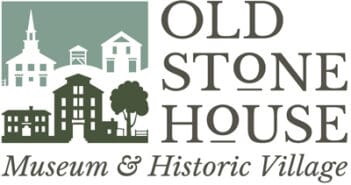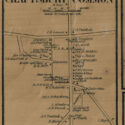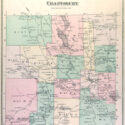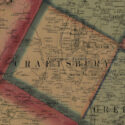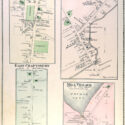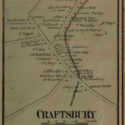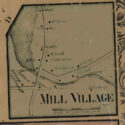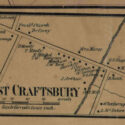Town Facts:
- Granted to Ebenezer Crafts in 1791
- First called Minden, then changed in 1790 to Craftsbury to honor Ebenezer Crafts
- Four settlements: Craftsbury village, East Craftsbury, Mill Village and Craftsbury Common
Town History
From the Vermont Historical Gazetteer, edited by Abby Maria Hemenway. Orleans County – Craftsbury Chapter: By Hon. W. J. Hastings. Published by Claremont Manufacturing Co, 1877. Pg 164-167
Craftsbury, in Orleans County, is bounded N. by Albany, S. by Greensboro, E. by Wolcott, W. by Eden. It is situated about 25 miles south of Canada line and about 30 miles north of Montpelier, and is about equidistant between Connecticut River on the east and Lake Champlain on the west. It is quite a good farming town though somewhat broken by hills, valleys, streams and ponds. There are five natural ponds in this town, viz. Elligo, lying partly in Greensboro; Great Hosmer, partly in Albany; Little Hosmer and two smaller ponds.
Black river is formed in this town by the union of several small streams flowing from the three large ponds above mentioned, Trout Brook and Nelson Brook. On these streams are several valuable mill-privileges. The river, after receiving these tributaries, runs northerly 4 miles through the center of the town, continuing on through Albany, Irasburgh and Coventry and empties into Lake Memphremagog in Newport; its current is in general slow; the entire descent from Elligo Pond to Memphremagog Lake, including the two falls in IRasburgh and Coventry, being the actual measurement only 190 feet- the distance being 30 miles.
The valley of this river is a muck-bed averaging one-fourth of a mile in width on which grows a great quantity of meadow-hay. In addition to the streams above mentioned, is the Wild Branch which rises in Eden, runs through the western part of this town and empties into the Lamoille River in Wolcott. There are many excellent farms in this town, from which are exported large quantities of butter annually. The town was granted to Timothy Newell, Ebenezer Crafts, and their associates Nov. 6, 1780, and chartered by the name Minden, Aug. 23, 1781. The first settlement of the town was commenced in the summer of 1778, by Col. E. Crafts, who during that Summer opened a road from Cabot (18 miles), cleared 10 or 12 acres of land, built a saw-mill and made some preparations for a grist-mill. In the Spring of 1789, Nathan Cutter and Robert Trumbull moved their families into this township. Mr. Trumbull by reason of sickness in his family, spent the ensuing winter in Barnet, but Mr. Cutter’s family remained through the winter. Their nearest neighbors were Ashbel Shepard’s family in Greensboro, a distance of 6 miles. There were, at that time, no other settlements within the present limits of Orleans County. In November, 1790, the name of the town was altered to Craftsbury.
In February, 1791, Col. Crafts, having previously erected a grist-mill and made other improvements, together with John Corey, Benjamin Jenkins, Daniel Mason, John Babcock and Mills Merrifield moved their families from Sturbridge, Mass.; arriving at Cabot they found it impossible to proceed farther with their teams on account of the great depth of snow and were obliged to provide themselves with snow-shoes and draw the females on hand-sleds a distance of 18 miles. These settlers were soon followed by other families from Sturbridge and other parts of Worchester County. In March, 1792, the town was organized. Samuel C. Crafts was chosen town clerk and annually elected to that office until 1829, when Joseph Scott (then Jr.) was elected and still holds said office, having been annually elected for 39 years, with a fair prospect of holding it for several years to come; and probably the records of this town will compare favorably with those of any town in the State. At this first town meeting Ebenezer Crafts was chosen moderator; Ebenezer Crafts, Nathan Cutler, Nehemiah Lyon, selectmen, and Joseph Scott constable.
Among the most prominent men who held the town offices for the first 20 years after the organization of the town, were those already mentioned and Ephraim Morse, Nehemiah Lyon, Samuel French, Daniel Mason, Dan’l Davison, Arba Nelson, Dea. – Shaw and Leonard Holmes.
Craftsbury, at the time it was chartered, belonged to Chittenden County; it was subsequently annexed to Caledonia County and in 1792 Orleans County was incorporated and the courts were held alternatively in Craftsbury and Brownington. Irasburgh became the shire-town about the year 1815.
The two principal villages in town are the Common or Center Village and the South Village, one mile south of the Common. The Common was the only place of business for the first 30 years, the South village being a wilderness till 1818, but having the advantage of good water-power it is now quite as large as the Common; and the town-meetings are held there. There are two other small villages in town, one in the eastern part and the Mill Village, which is situated about one mile N. E. of the Common, in which has recently been erected a first-class flouring-mill. There are in town (1868) 3 churches, 1 academy, 1 woolen factory, 7 stores, 2 grist-mills, 5 saw-mills, 1 hulling-mill, 5 blacksmith-shops, 3 wheelwright-shops, 1 tannery, 1 tin-shop, 5 shoe-shops, 2 harness shops and 3 hotels.
This town from 1800 to 1825, or ’30, was the center of trade got all the towns around it; as late as 1818 or ’20, there was no store in Lowell, Westfield, Troy, Jay, Eden, Wolcott, Greensboro, Glover, or Albany. The trade of Greensboro was about equally divided between Hardwick and Craftsbury and Barton; nearly all the trade from the other towns mentioned came to Craftsbury, and there is now probably no other town in Orleans County (except Barton and Newport) where more goods are sold than in this.
Education
The first settlers early made provision for the education of the children. In 1775, the town voted to raise 25 bushels of wheat for the support of a school: in 1796 or ’97, the town voted to raise $90 to defray the expenses of building a school-house and in 1798, the town was divided into 2 school-districts; others were added from time to time as the wants of the people demanded, and there are now 14 school districts in town with good school-houses in most of them, and the education of the children well cared for.
Craftsbury academy was incorporated in 1829, and has been in operation one of more terms nearly every year since: the large brick academy which was built at the time of incorporation, was this year (1868) taken down and a new and commodious one erected in its stead; the school is now in a prosperous condition under the superintendence of Mr. L. H. Thomson and Miss A. Nichols.
Religious- Congregational Church
In 1797, a Congregational church was organized, and Rev. Samuel Collins was settled as pastor, and continued to preach in this town till 1804, when he died; from that time until 1822, they had no settled minister in town: during the year mentioned, the Rev. Wm. A. Chapin was ordained pastor, which office he held about 12 years, when he was dismissed at his own request and was succeeded by Revs. S. R. Hall, A. O. Hubbard, I. Hoadley and E. P. Wild, who is the present pastor.
Methodist Episcopal Church
The present Methodist church was organized in 1818, under the labors of Rev. Wilbur Fisk, and was united in a circuit with several other towns till about 1830, when it became a station of itself and has maintained preaching from that time to the present, — usually changing preachers once in 2 years. There are 175 church-members and over 250 members of Sabbath school, and 300 volumes in the Library. The Methodist church is located at the South village, the Congregational church at the Common.
There is also a society of Presbyterians or Covenanters in the east part of the town, several of the members of which live in Greensboro and Glover: they have a respectable house of worship, a parsonage and a settled minister, Rev. Johnson. There was for many years a Calvinist Baptist society in town, also a society of Univeralist [sic], both of which have been extinct.
Physicians
Dr. James Paddock was the first physician in this town, he married Augusta Crafts, daughter of Col. E. Crafts, with whom he lived but a few years when he died, leaving 2 sons, James A., who became a lawyer and lived in the town until his death in 1867, and Wm. E., the younger who became a merchant and lived in town until his death in the summer of 1855. Dr. Ephraim Brewster succeeded Dr. Paddock as physician and also married his widow with whom he lived till about 1813, when he died while acting as surgeon in the war with Great Britain; leaving one son who bears his father’s name and is now a practicing physician in town; his widow afterwards married Benjamin Clark with whom she lived some 20 or 25 years when he died; she lived until 1861 and died at the advanced age of 88 years and 6 months. She was truly a mother in Israel, loved and respected by all who knew her. Dr. Wm. Scott succeeded Dr. Brewster and was the only physician in the place until Dr. Daniel Dustin come to town in 1822, and was the principal physician for 30 years and still has a good practice. He married Laura Corbin, daughter of Royal Corbin, and grand-daughter of Col. Crafts, with whom he lived about 25 years. He has long been one of our most influential and esteemed citizens.
There are at present 4 physicians in town, viz. Daniel Dustin, Ephraim Brewster, S. R. Corey and George Davis.
The population of this town in 1860, was 1413- and the grand list in 1867, $4800.53.
